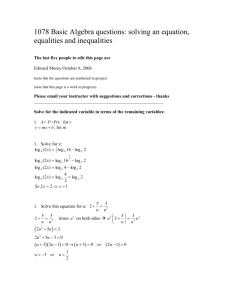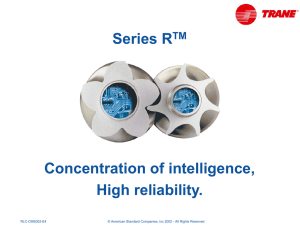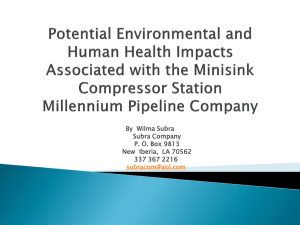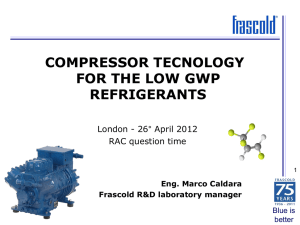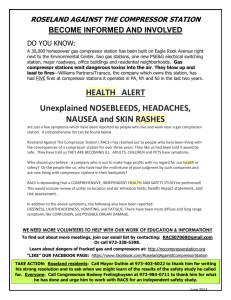right-click to
advertisement
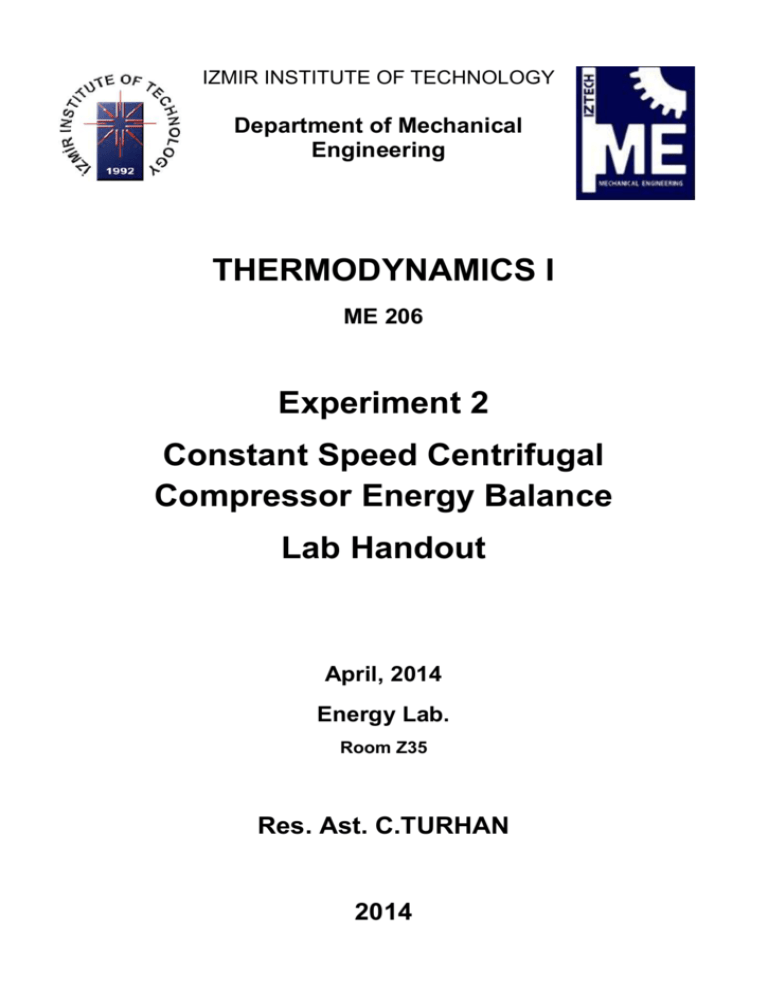
IZMIR INSTITUTE OF TECHNOLOGY Department of Mechanical Engineering THERMODYNAMICS I ME 206 Experiment 2 Constant Speed Centrifugal Compressor Energy Balance Lab Handout April, 2014 Energy Lab. Room Z35 Res. Ast. C.TURHAN 2014 1. Introduction Compressors are devices used to increase the pressure and the kinetic energy of a fluid for utilizing it in desired purposes like in heating-ventilating-air conditioning applications. Work is supplied to these devices from an external source through a rotating shaft to compress the fluid in it to very high pressures. The objective of the experiment is to utilize the conservation of mass and energy laws for steady state conditions on a centrifugal air compressor and to find its first law efficiency. 2. Theory and Principles In the experiment, a centrifugal compressor is utilized to compress air to a higher pressure. The general relationship between the various forms of energy, based on the 1 st Law of Thermodynamics applied to a unit mass of fluid flowing through a control volume, which is the compressor itself in this experiment, is expressed as Ws ke pe P F 1 where Ws is the mechanical shaft work performed on the fluid, ke is the change of kinetic energy of the fluid, pe is the change in potential energy of the fluid, p is the change in pressure energy, and F is the frictional energy loss as heat to the surroundings or in raising the temperature of the fluid itself as it travels from inlet to outlet of the compressor. When the equation 1 is written explicitly, it becomes v 2 v 2 1 g ( z z ) p2 p1 F Ws 2 2 1 2 2 where v , g , z , p ,and represent the velocity of the fluid in m/s, gravitational acceleration in m/s2, elevation in m, pressure in N/m2, and the density of the fluid in kg/m 3, respectively, subscripts 1 and 2 refer to the compressor inlet and outlet. The first three terms on the right hand side of the equation 2 represent useful work Wa . v 2 v 2 1 g ( z z ) p2 p1 Wa 2 2 1 2 3 The term Wa represents the actual work performed in changing the energy stages of a unit mass of the fluid. This may alternatively be represented as the compressor total pressure ptc , by converting the units from work per unit mass to pressure by multiplication two sides of equation 3 with and it yields v 2 v 2 2 1 ptc p2 p1 2 4 The change in potential head of the fluid is ignored as the change in atmospheric pressure between the inlet and outlet is negligible. Friction losses have also been ignored, and for the purposes of the following experiments it is assumed that the fluid is incompressible ( is constant). The mechanical power input, Pm , to the compressor can also be expressed as Pm 2 .n.t / 60 5 where n is the revolution of the shaft per minute, t is the motor torque in Nm. The compressor power output, Pu , based on Pm and volume flow rate may be expressed as Pu Q v ptc 6 where Q v is the volume flow rate of the air in m3/s and it is expressed as follows C d 2 2 p0 Q v d ptc 4 7 where C d , d , , p0 indicate the coefficient of discharge for the orifice, the orifice diameter in m, the density of the air in kg/m 3, and the differential pressure across the orifice in N/m, respectively. According to equation 5 and equation 6, the efficiency of the compressor is Pu 100 Pm 8 3. Experimental Set-up The experiment is conducted with the experimental setup of “Armfield FM42 Centrifugal Compressor Demonstration Unit” which consists of “Armfield IFD7 Interface Device” and a compatible PC running “Armfield FM42-304 software”. The experimental setup includes one temperature sensor and two pressure transducers at the inlet and one pressure transducer at the outlet of the centrifugal compressor. At the outlet of the compressor, there is a rotary outlet aperture to adjust the air outlet resistance. The compressor speed can be increased or reduced by the software to obtain different pressurization levels of the air and compare different operation conditions. In Figure 1, the experimental setup and its instrumentation are shown. Air Inlet Air Outlet Figure 1. Experimental setup 4. Procedure Close the rotary outlet aperture to give significant system resistance, for instance 2/3 closed. Set the compressor speed to maximum 100%. Click the “Go” button on the software to take a sample. Using the discharge as a guide, select incremental values for discharge that will give 10-15 individual steps between minimum and maximum velocity. Reduce the compressor setting gradually to reduce the discharge by approximately the increment chosen. Allow the flow to stabilize then click “Go”. Open the aperture to increase the flow rate to the first increment. Click “Go” to take a sample. Repeat for each increment until the aperture is fully open. If time permits, repeat the above procedure for compressor speeds of 80%, 60%, 40% and 20%. Note measurements for each trial. Measured Parameters Inlet Temperature Orifice Differential Pressure p0 1 2 3 Compressor Differential Pressure p2 p1 Compressor Speed n Motor Torque t 5. Results Calculate the following parameters. Air Density Volume Flow Rate Q v Compressor Total Pressure ptc Mechanical Power (Input) Pm Compressor Power (Output) Pu Efficiency Plot graph of compressor total pressure against volume flow rate. Plot graph of compressor efficiency against volume flow rate. Plot graph of mechanical power against volume flow rate. Plot graph of compressor power output against volume flow rate. Describe the compressor performance characteristics of the compressor. Make your comment on the results. 6. References [1] [2] Cengel Y., Boles M. A., Thermodynamics: An Engineering Approach, McGraw-Hill, Fifth Edition Instruction Manual Armfield FM42

